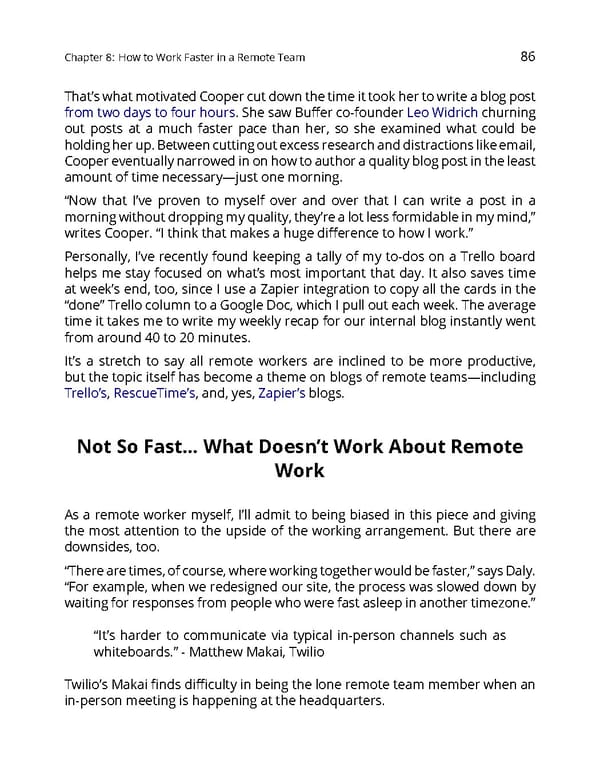Chapter8: HowtoWorkFasterinaRemoteTeam 86 That’swhatmotivatedCoopercutdownthetimeittookhertowriteablogpost fromtwodaystofourhours.ShesawBufferco-founderLeoWidrichchurning out posts at a much faster pace than her, so she examined what could be holdingherup.Betweencuttingoutexcessresearchanddistractionslikeemail, Coopereventuallynarrowedinonhowtoauthoraqualityblogpostintheleast amountoftimenecessary—justonemorning. “Now that I’ve proven to myself over and over that I can write a post in a morningwithoutdroppingmyquality,they’realotlessformidableinmymind,” writes Cooper. “I think that makes a huge difference to how I work.” Personally, I’ve recently found keeping a tally of my to-dos on a Trello board helps me stay focused on what’s most important that day. It also saves time at week’s end, too, since I use a Zapier integration to copy all the cards in the “done”TrellocolumntoaGoogleDoc,whichIpullouteachweek.Theaverage time it takes me to write my weekly recap for our internal blog instantly went fromaround40to20minutes. It’s a stretch to say all remote workers are inclined to be more productive, but the topic itself has become a theme on blogs of remote teams—including Trello’s, RescueTime’s, and, yes, Zapier’s blogs. NotSoFast…WhatDoesn’tWorkAboutRemote Work As a remote worker myself, I’ll admit to being biased in this piece and giving the most attention to the upside of the working arrangement. But there are downsides,too. “Therearetimes,ofcourse,whereworkingtogetherwouldbefaster,”saysDaly. “For example, when we redesigned our site, the process was slowed down by waitingforresponsesfrompeoplewhowerefastasleepinanothertimezone.” “It’s harder to communicate via typical in-person channels such as whiteboards.” - Matthew Makai, Twilio Twilio’s Makai finds difficulty in being the lone remote team member when an in-person meeting is happening at the headquarters.
 The Ultimate Guide to Remote Work Page 89 Page 91
The Ultimate Guide to Remote Work Page 89 Page 91